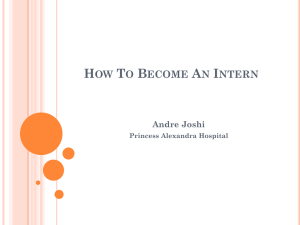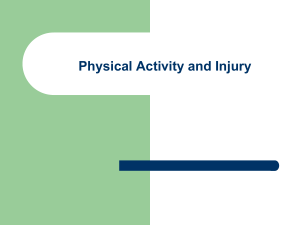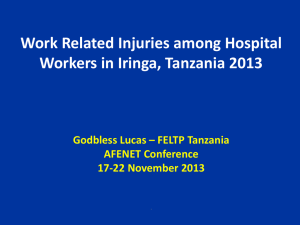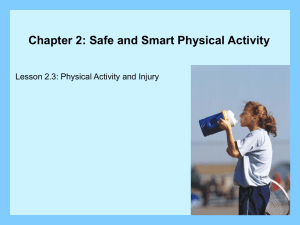Presentation
advertisement
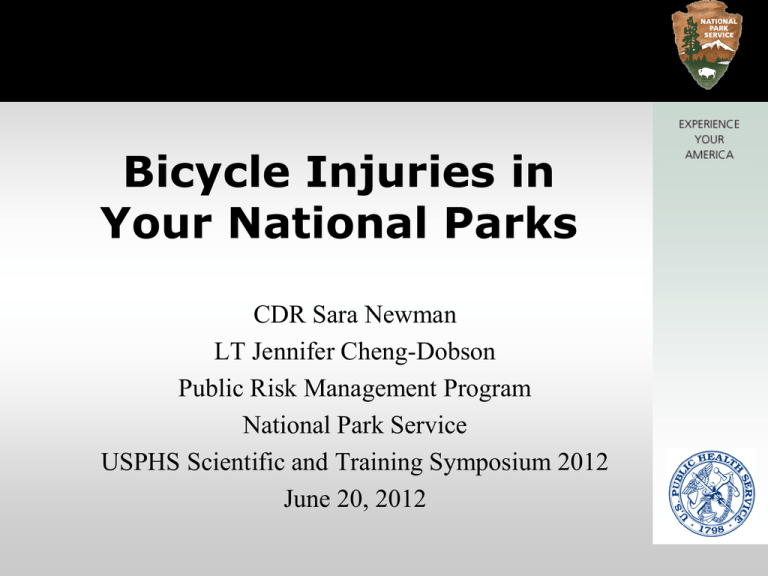
Bicycle Injuries in Your National Parks CDR Sara Newman LT Jennifer Cheng-Dobson Public Risk Management Program National Park Service USPHS Scientific and Training Symposium 2012 June 20, 2012 Overview • Background • Bicycle injuries in the National Park Service (NPS) • Prevention strategies in parks • Case examples National NationalPark Service Regions Injuries in the U.S. • Injury is the leading cause of death among persons ages 1-44 (2007) • 1 person dies from injury every 3 min • > 2.8 million hospitalized each year • > $406 billion in medical costs and lost productivity CDC. www.cdc.gov/injury/overview/leading_cod.html. 2007 Bicycle Injuries in the US (2010) • 618 fatal – 87% male – 64% between ages 25-64 years • 51,000 non-fatal – 80% male – 51% between ages 25-64 years • $4 billion/yr NHTSA www.bicyclinginfo.org 2009 "If a disease were killing our children at the rate unintentional injuries are, the public would be outraged and demand that this killer be stopped." -C. Everett Koop, US Surgeon General 1982-1989 Injuries in our national parks • On average 3 visitors die in our parks every week* • An average of 14 people are seriously injured in our parks every day Source: GPRA 2005-2011 * Due to Unintentional Injuries or Accidents Distribution of Injuries • 100% of fatal injuries reported by 55 parks (2011) • 97% of injuries reported by 100 parks (2011) Source: PMDS 2011* Due to Unintentional Injuries Demographic of Visitor Injuries • 76% male, 17% female (7% unk) NPS Fatal Visitor Injuries, by Age, FY2011* 30 24 Number of Fatalities 25 20 21 20 18 17 15 13 10 5 4 0 10 and under 11-21 22-34 35-44 Age Group PRMP Visitor Injury Data System N=117, Unknown = 38 45-54 55-64 65+ Unintentional Visitor Fatalities, by Cause, FY2011 0 10 20 30 50 60 70 64 Drowning 29 Motor vehicle crash 28 Fall/Slip 17 Natural/Environmental Wildlife/Animal 40 4 PRMP Visitor Injury Data System N=155 Bicycle Injuries in NPS Brenna Woziak. PRMP Visitor Safety Intern, 2011 NPS Bicycle Fatalities • • • • 2007-2011: 12 bike related fatalities 83% male 75% between the ages of 25-65 25% involved collision with a motor vehicle Studying three national parks • George Washington Memorial Parkway, Mount Vernon Trail (VA/DC/MD) • Cape Cod National Seashore (MA) • Chesapeake and Ohio Canal National Historic Park (DC/MD/WV) • Others: Saguaro (AZ), Golden Gate (CA), Rock Creek Park (DC/MD) Bicycle Injury Results • Bicycle injuries were the leading cause of injury at each park • Fatal bike injuries at one park • More females than males at Cape Cod • Between 56%-71% between ages 25-64 Prevention Strategies – 3E’s • Engineering • Enforcement • Education National Park Service Mission “ …to conserve the scenery and the natural and historic objects and wild life therein and to provide for the enjoyment of the same in such manner and by such means as will leave them unimpaired for the enjoyment of future generations.” Title 16 Chapter 1, Section 1 Organic Act of 1916 Park Service Challenges • Multiple types of terrains – – – – Trails (paved and not) Roads Trails crossing roads Uneven pavement • Can’t always meet industry standards • Multiple jurisdictions • Limited environment control George Washington Memorial Parkway, Mount Vernon Trail (DC/MD/VA) Charles Opalak. PRMP Visitor Safety Intern, 2010 City of Alexandria Junior Bike Ambassadors George Washington Memorial Parkway, VA/DC/MD Trail ride with a ranger Charles Opalak. PRMP Visitor Safety Intern, 2010 Mutual outreach at Trail Days Trail Days – Mount Vernon Trail George Washington Memorial Parkway, VA/DC/MD Education Bike bell installation Brochures and maps Charles Opalak. PRMP Visitor Safety Intern, 2010 2010 Trail Pledges & Contact Cards George Washington Memorial Parkway, VA/DC/MD Charles Opalak. PRMP Visitor Safety Intern, 2010 Bicycle Safety at the Seashore Cape Cod National Seashore, MA Brenna Woziak. PRMP Visitor Safety Intern, 2011 Cape Cod National Seashore, MA Brenna Woziak. PRMP Visitor Safety Intern, 2011 Cape Cod National Seashore, MA Brenna Woziak. PRMP Visitor Safety Intern, 2011 Bicycle Safety at the Seashore Cape Cod National Seashore, MA Brenna Woziak. PRMP Visitor Safety Intern, 2011 Bicycle Safety at the Seashore Cape Cod National Seashore, MA Brenna Woziak. PRMP Visitor Safety Intern, 2011 Safety Signs Cape Cod National Seashore, MA Brenna Woziak. PRMP Visitor Safety Intern, 2011 Successful Prevention Strategies Haleakala National Park, HI Sara Newman, 2007 Cuyahoga Valley National Park, OH Luke Hamilton. PRMP Visitor Safety Intern, 2009 Safe is Sound • Reduced injuries by 83% in target areas • Removed poles blocking road • Extended rails on trails • Enhanced education to cyclists Cuyahoga Valley National Park. 2012 Data Limitations/ Challenges • Incomplete injury data • No injury rates • Lacking detailed and accurate visitation data • Lack of dedicated staff in public risk management Summary • Injury prevention in the national parks provides a unique challenge • Combining the 3E strategy has worked • More effective strategies result from better data Next Steps • Enhance data • Focus on program evaluation Acknowledgements • • • • • Charles Opalak Brenna Woziak Brian Werner Cuyahoga Valley National Park, OH Haleakala National Park, HI CDR Sara Newman, DrPH, MCP Sara_newman@nps.gov (202) 513-7225 LT Jennifer Cheng-Dobson, MPH Jennifer_cheng@nps.gov (202) 513-7219



